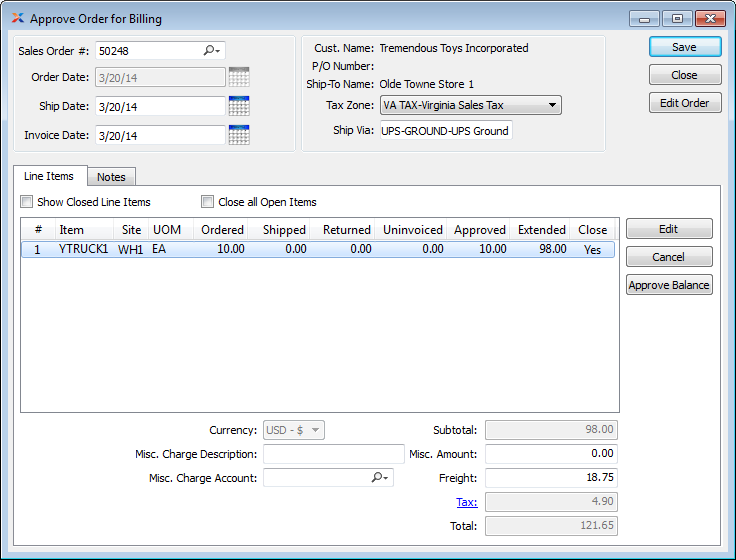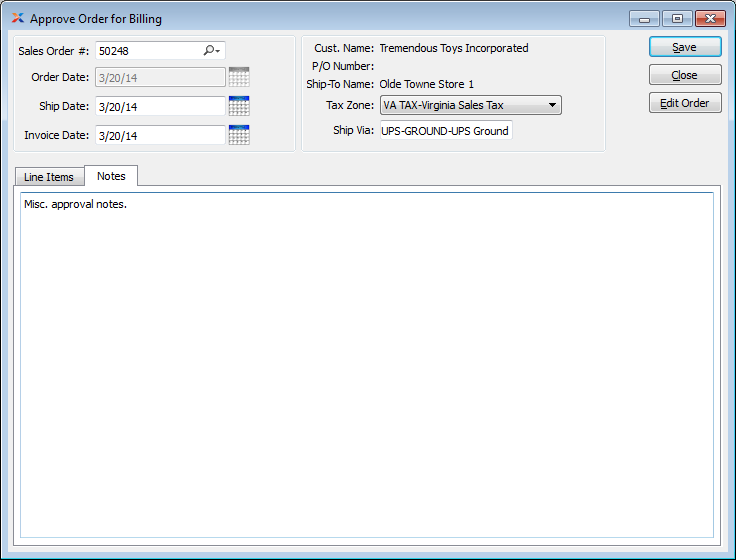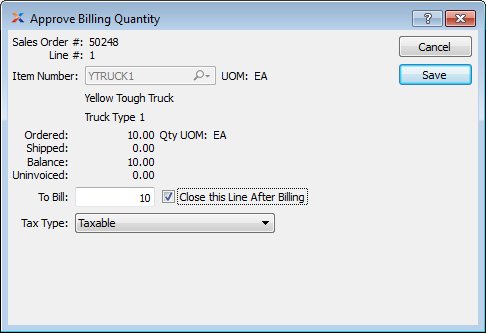
|
xTuple ERP Reference Guide |
This utility enables you to manually enter billing details for individual Sales Order Line Items. Both shipped Orders and unshipped Line Items may be selected for billing in this manner. This individualized approach differs from the approach taken by the Select All Shipped Orders for Billing utility, which by default selects for billing the full Line Item quantities for all shipped Orders. To select an individual shipped Order for billing, select the "Approve Order for Billing" option. The following screen will appear:

When you select an Order for billing, you are indicating that you wish to create an Invoice for the Order. Invoice Numbers are assigned when an Invoice is printed.
When selecting an Order for billing, you are presented with the following options:
Enter the Sales Order Number of the Sales Order you want to select for billing.
Displays the original Sales Order date.
By default, the most-recent ship date will appear in the field. You may override the default value by entering ship date information manually.
By default, the current (today"s) date will appear in the field. You may override the default value by entering Invoice date information manually.
Name: Displays Customer's name.
Displays purchase for the specified Sales Order. Indicates the Customer Purchase Order Number assigned to the specified Sales Order.
Displays Ship-To name.
Specify the Tax Zone associated with the Sales Order. The Tax Zone for the specified Ship-To Address will be entered here by default. Otherwise, the primary Tax Zone for the Customer will be entered.
By default, the preferred Ship Via method for specified Customer will appear in the field. You may enter a free-form Ship Via simply by typing the name of the Ship Via into the field. Default Ship Vias may be defined at the system level.
The system supports up-to-date shipment tracking with links to the websites of many leading shipping companies (i.e., "Ship Vias").
Select to show closed Line Items in the "Line Items" display.
Select to close all open Sales Order Line Items.
Displays the Sales Order Line Items selected for billing. Double-clicking on a Line Item—or highlighting it and selecting the EDIT SELECTION button—enables you to select a billing quantity for that Item.
In the Line Items display, the Uninvoiced column refers to quantity that has been shipped but not yet invoiced. Quantity must have been shipped to appear in the Uninvoiced column. If no quantity has been shipped, then no quantity will appear as uninvoiced.
Displays the subtotal for the Sales Order Line Items.
Displays the amount of Tax that will be added to the Sales Order, as defined by the specified Tax Code. To get a detailed view of the Tax calculation, click on the Tax link using your mouse.
Enter the amount of the miscellaneous charge. Before entering a miscellaneous charge amount, you must first assign the charge to a Sales Account and also enter a description of the charge.
Enter a description to identify the miscellaneous charge.
Enter a Sales Account to assign the miscellaneous charge to.
Enter the amount of freight charge to be added to the specified Order. The freight charge may be entered during the creation or modification of a Sales Order—or at the time of shipment.
The Payment Received field is an optional field which may be used to provide visibility into prepaid amounts. Because the field exists for visual purposes only, entering an amount in this field will not affect the amount due. The only way an Invoice may be offset is through the application of a Cash Receipt or a Credit Memo.
Displays the total amount of all uninvoiced Sales Orders.
The following buttons are unique to this screen:
Brings you to the Sales Order screen, where you may edit the specified Sales Order. The Sales Order screen is described at length in Section 2.1, “New Sales Order”.
Highlight a Line Item, then select this button to transfer the full balance to Billing.
When the Notes tab is clicked, the screen will appear as follows:

This is a scrolling text field with word-wrapping for entering Notes related to the Sales Order selected for billing. Notes entered on this screen will follow the Order through the billing process. For example, you may view notes associated with a posted Invoice within the Invoice Information report.
To specify billing quantities for Line Items in the "Approve Order for Billing" screen, double-click on a Line Item in the "Line Items" display—or highlight the Line Item and select the EDIT SELECTION button. The following screen will appear:

When selecting the billing quantity for a Line Item, you are presented with the following options:
Displays Sales Order Number.
Displays Sales Order Line Item Number.
Displays Item Number of Line Item.
Inventory Unit of Measure.
Displays quantity ordered.
Displays quantity shipped.
Displays remaining quantity to be shipped.
Displays uninvoiced quantity.
Enter the quantity you want to select for billing.
Select to close the specified Line Item after billing.
If you are shipping a partial quantity to a Customer, be sure to leave the "Close this Line After Billing" option unchecked. This will ensure the Sales Order Item remains open until the full quantity has been shipped.
Select the Tax Type to be applied from the drop down list.